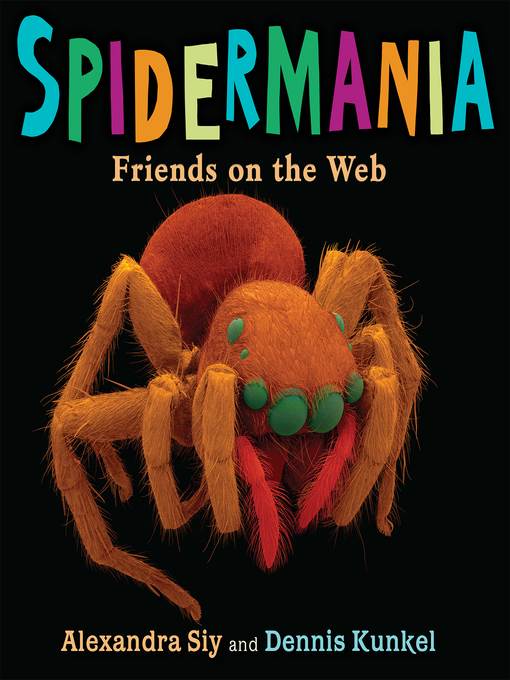
Spidermania
Friends on the Web
کتاب های مرتبط
- اطلاعات
- نقد و بررسی
- دیدگاه کاربران
نقد و بررسی

August 31, 2015
In this companion to Bug Shots (2011), Siy explains that arachnids are worthy of fascination, not fear. Kunkel’s electron micrograph photographs zoom in on the subjects, giving them an almost puppetlike appearance, even as the descriptions convey their predatory natures. “Toxic venom is delivered through an opening near the end of each fang, similar to the opening in a hypodermic needle,” Siy writes of the brown recluse. Vibrant coloring makes it easy to identify the spiders’ anatomical features, and after learning about bionic eyes, “ballooning” spiderlings, and other topics, readers should be impressed by the arachnids’ versatility and capability, even if they aren’t quite ready to cuddle up with them. Ages 6–10.

August 15, 2015
For their latest memorable venture into microscopic worlds, two veteran collaborators bring children face to face with the original "web masters" (Bug Shots, 2011, etc.). "To know a spider you must first look into its eyes." Along with being a proposition as riveting as it is uninviting for most readers, Siy's observation is literally true, as the arrangement of their multiple eyes is often a key to spider identification. Expanding on her taxonomic topic, the author focuses on observable behaviors and physical characteristics throughout a general overview and brief introductions to 10 arachnids. She closes with specific methodology that includes both a chart of eye patterns and a set of systematic questions that will help distinguish true spiders from close relatives. As always, Kunkel's bright, sharp, close-up photographs and even closer-up electron micrographs, all with detailed production notes, are a highlight-the former artfully angled to show body parts and coloration, the latter using false colors to make spinnerets and other tiny physical features easily visible. Though the author's argument that spiders are our friends (in support of which she even enlists E.B. White's Charlotte) is vitiated by frequent images and mentions of black widows, brown recluses, some Australian spiders, and how seldom anyone actually dies from venomous bites, the mixed message will still draw both budding naturalists and readers after cheap thrills in equal numbers. An unusual approach to the creepiest of crawlies, likely to snare unwary passers-by in droves. (index, multimedia resource lists, glossary) (Nonfiction. 8-11)
COPYRIGHT(2015) Kirkus Reviews, ALL RIGHTS RESERVED.

December 1, 2015
Gr 4-6-A brilliantly colorized microphotograph of a jumping spider crouches on the dust jacket like some alien nightmare, an electric lure to attract browsers to the many enlightening pages that follow. Many other Scanning Electron Microscope (SEM) photos, also colorized, are strewn about, offering vivid details of spinnerets, fangs, and eye patterns; regular color photos of spiders are included as well. The writing flows well, and Siy discusses a wide selection of arachnid topics-basic physiology, behaviors, and silk, for instance-before branching into specific varieties. Some of the species examined are the diving bell spider, the daddy longlegs spider (not to be confused with the equally long-legged harvestman), the wolf spider, and, of course, the black widow. Asides on topics such as courtship, parenting, and web-building are interspersed throughout, and the book ends with Siy delving into how she and Kunkel identified an unknown spider sample. She also explains how the dramatic SEM photos so liberally lavished throughout were taken and colorized. Back matter, which features information on eye-patterns, an identification key to eight common orders, and a segment on spider classification, is sure to delight educators. Similar in scope to Seymour Simon's handsome (nonindexed) Spiders (HarperCollins, 2004, 2007) and Nic Bishop's dramatic Spiders (Scholastic, 2007), this eye-catcher will appeal to students. VERDICT Arresting photos and illuminating text weave a neat web to capture readers.-Patricia Manning, formerly at Eastchester Public Library, NY
Copyright 2015 School Library Journal, LLC Used with permission.

November 1, 2015
Grades 2-5 Featuring abundant boldly colored visuals and a wealth of information, Siy and Kunkel (Bug Shots, 2011) offer a lively introduction to spiders. The book first covers general characteristics and behaviors, from their physical makeup to how they create silk. Then they go on to discuss 10 spider types, such as black widows, tarantulas, and orb-weavers, as well as the diving bell spiders, which live underwater. Siy's clearly written text then addresses spiders' unique aspects, typical life cycles, and whether they're poisonous to humans. Siy conveys scientific concepts and terminology very well, and her text is nicely complemented by Kunkel's detailed, vivid photographs and digitally enhanced electron micrographs, all of which are accompanied by descriptive captions. Though some squeamish or bugphobic folks might balk at the large photos (and shudder to learn about common household hiding spaces for spiders), readers will come away with a fairly comprehensive understanding of spiders and spider diversity. The extensive back matter includes the typical elements as well as a guide for recognizing and identifying particular spiders by eye pattern.(Reprinted with permission of Booklist, copyright 2015, American Library Association.)

























دیدگاه کاربران